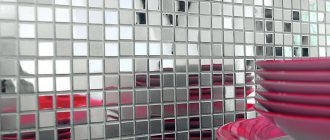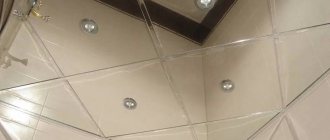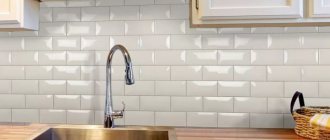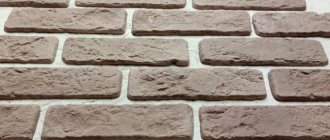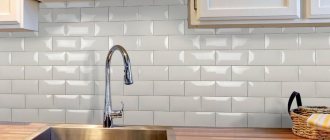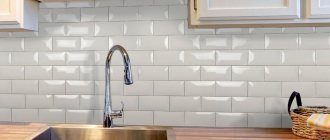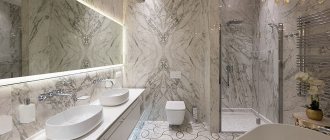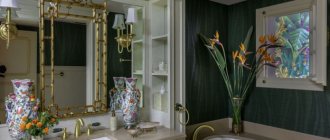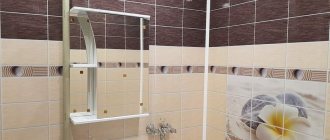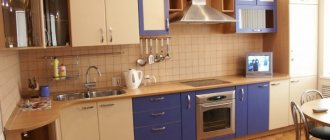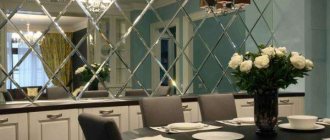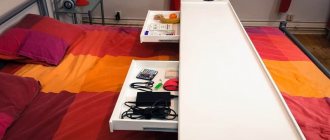The use of mirror mosaics in the interior is now very relevant. Such decoration can give the space a truly amazing, magical and mysterious character. The mirror finish of various areas of the room will attract the attention of any visitor, especially when the sparkling pieces sparkle with reflections of light. A room decorated with mirror mosaics will always look formal and solemn. Even small mirror fragments in the decoration of walls or ceilings will add a special “zest” to the interior.
Pros and cons of use in the interior
Pieces of mirrors have long been used in interior decoration. Previously, a mosaic panel could be made from fragments of a broken mirror. Modern mosaics are made from particularly durable material. It has proven itself to be the best due to its features:
| Advantages | Flaws |
| It is resistant to abrasion and does not lose its shine over time. | If the mosaic is not fixed to the grid, but consists of individual parts, installation takes a lot of time and effort. |
| It is environmentally friendly, and is not afraid of moisture and aggressive detergents. | If a room decorated with mosaics is not ventilated, under the influence of moisture the canvas fogs up and darkens. |
| Strong and durable material, temperature changes do not affect it in any way. |
Care Tips
Although the mosaic is designed for use in bathrooms, where high humidity, dampness, steam, and temperature changes are common phenomena, nevertheless, in order to preserve the appearance and functionality of the mosaic cladding, one should not neglect the basic rules of its maintenance.
What is recommended to do:
- Regularly clean the surfaces with mild, gentle detergents, regardless of the fact that mosaic materials are resistant to most chemicals and have water-repellent properties.
- Remove greasy stains on seams with fat-dissolving compounds.
- To maintain the ideal condition of the seams, it is necessary to treat them with special means to combat mold, fungi and bacteria. The effects of such compositions usually last for six months.
- Installing a high-quality ventilation system in the bathroom completely solves the problem of removing excess moisture, which reliably limits its access to the tile seams where mold appears.
Mirror mosaic finishing options
Mirror mosaic is a truly universal material. It looks great on any surface: walls, ceilings and even interior items - furniture, fireplaces, mirrors. Adding mirror strips or inserts to the decoration will help transform the space of the apartment. Installation of tiles attached to the mesh is easy: the canvas is glued to the prepared surface. The grout can be white or graphite in color.
Kitchen apron
Because of its advantages, a mirror panel is often installed in the kitchen as an apron. This decor not only expands the space, but also protects the wall from dirt in the cooking area.
Walls
The surface finished with mirror mosaic is very practical, so it can be tiled in any corner of the house: kitchen, bedroom, living room. This decor looks great in hallways and can also decorate a bathroom.
The photo shows a bathroom in a minimalist style. The interior is enlivened by a wall of combined mosaic tiles that form a pattern.
Ceiling
It is recommended to decorate part of the ceiling with mosaic tiles to avoid overcrowding the interior. The area where the chandelier hangs is successfully decorated: its mirror surface reflects light and casts picturesque reflections on the walls. The mosaic edging laid around the perimeter of the ceiling looks original - it increases the amount of daylight coming from the windows.
Wardrobe facade
You can decorate almost any furniture with mirror fragments: tables, cabinets, kitchen islands, bar counters. The façade of the wardrobe, decorated with mosaics, looks extraordinary.
The photo shows a wardrobe with a door decorated with mirror squares. Diagonal laying echoes the floor covering, and beveled edges make the interior richer.
Frame for a picture or mirror
Interior items decorated with mosaics always look stylish and original. You can make such a mirror with your own hands by gluing mosaic pieces to any surface.
Niche
A niche decorated with mini-mirrors will become the “highlight” of the interior, visually enlarging it and attracting the attention of guests.
The photo shows a fragment of a kitchen with a niche decorated with thin shiny stripes that visually deepen the space.
Fireplace
Mosaic is resistant to high temperatures and, despite its external fragility, is very durable. This coating is ideal for cladding a fireplace portal.
Laying features
Before laying, the tiles must be inspected for damage. For this purpose, it is better to lay out all the blocks on the floor or any other hard surface. They need to be measured and compared with each other so that the size is the same - this is necessary to create an even pattern.
Glue is immediately applied to the tiles. At this time, special markings are made on the wall and a screed is laid. Then the glue is applied to the wall. You should avoid a layer that is too thick - the glue will not have time to dry and after a while the tile will simply slide to the floor.
Cut the mosaic tiles with special metal tongs or a construction knife. After a few days, grout each seam without risking moving the tiles out of place.
Substrate options
- Paper. The chips are glued to the paper base with the front side. This makes it easier to apply them to the wall. There are two main disadvantages: firstly, if moisture gets on the base, a separate element may come off prematurely, for example, during transportation. And secondly, you can evaluate the result and integrity of the parts only after they are fixed to the wall (when the base is peeled off). So you will find out late about the presence of chips and cracks on the front side.
- Net. The principle of operation is slightly different here. The chips are glued on the back of the mesh, so you can immediately see their quality. The disadvantage of this base is that it reduces the area of contact between the tiles and the adhesive.
- Hitch. This is the most convenient base from a work point of view. The chips are connected to each other by drops of glue. Sheets come in larger sizes: 30 x 60 cm, which significantly increases the speed of working with them.
Preparation
First, prepare the wall. It should be as even as possible so that the tiles do not go into “waves”. The old coating will have to be removed; it fits well only on wood and drywall.
Required tools:
- Spatula for applying glue.
- A utility knife to cut the film.
- Metal tongs or a utility knife for cutting tiles.
It is recommended to putty the walls and coat them with a primer, and seal all cracks and recesses. You can level the wall using a building level, which shows the angle of inclination.
Marking
Marking is necessary to ensure that the tiles lie in even rows. The markings are applied with a pencil with a thick lead or a cord with a weight, which is attached to the ceiling and ensures a perfectly straight line.
Tile laying options:
- Basic . The tiles are laid alternately, on the same level. The distance between elements is minimal.
- Chess board . The layout is carried out according to the basic principle, but elements of contrasting colors are used, alternating with each other.
- Linear . The pattern is formed in even rows, the tiles are laid one after another.
- "On the run" . The sutures are displaced relative to the mosaic segment. Suitable for round mosaics and laying out panels.
- Modular . There is deliberate negligence, tiles of different sizes are placed on a special drawing.
Grout
Proceed to grouting the joints no earlier than one day after laying the tiles, otherwise the risk of moving them out of place is very high. For grouting you will need a spatula and a rubber sponge.
Remove the protective film (if any). Using a spatula, start grouting first horizontally, then vertically. Remove the remains with a sponge.
Mosaic tile design ideas and shapes
Modern mosaic is represented by a wide range. Types of mirror tiles differ in the type of processing, shape, shades and size.
- The edges of products are processed in different ways: the surface can be ground or polished. A bevel is also used, which gives the tiles additional volume.
- On sale there are not only square-shaped products, but also in the form of rhombuses, rectangles, and hexagonal honeycombs. Round tiles are particularly original.
- To diversify the usual “silver” mirror shade, manufacturers have learned to tint products to look like black mirror, bronze and gold.
The photo shows a bathroom in which the space is uniquely expanded due to combined mirror parts of different sizes.
The mosaic also differs in its size: from small (10x10 mm) to large (several centimeters in area).
Color selection
Let's look at the main colors in the bathroom:
- White is the most popular shade. The trend is bright, rich colors, so any rich color will become an accent: red, blue, green, chocolate, etc.
- Black. If the walls are decorated with black mosaic tiles for the bathroom, then the ceiling and floor must be made white or beige. Accents (panels, drawings) in the form of bright spots are spectacular.
For a luxurious, all-black bathroom, scarlet glossy objects will look amazing: furniture, bathtub, mirror frame. A small pattern on the floor will complete the look.
- Beige is the best background for a full-wall painting. Pleasant to the eye, it is loved by owners of houses or apartments.
- Gray - a seemingly “boring” tone has many shades, the best combination with blue. But you can also choose pale pink, sand, lilac shades, etc.
- Brown and chocolate paints can be effectively diluted with pastel colors in the form of inserts or panels.
Photos in the interior of the rooms
Mirror canvases have always added solemnity to the interior and expanded the space. Mosaic tiles look impressive, and most importantly, they provide ample opportunities for creativity: they can be combined with other materials, combine different sizes and shapes, and create shaped compositions.
In the kitchen
The mirror finish goes well with the chrome surfaces of the cookware. If the kitchen is combined with the living room, such an apron will become an additional decoration of the interior.
The photo shows a kitchen with a figured mosaic in the form of a hexagonal honeycomb.
In the bathroom and toilet
Small rooms will become wider and brighter if you decorate them with mosaics. Usually one wall or element of the bathroom is allocated for this: a countertop, a shower stall or an area where the mirror is located.
In the bedroom
A composition of mini-mirrors can be placed at the head of the bed or opposite the bed. In a small room, vertical panels would be appropriate. Thanks to this interesting technique, the bedroom can be made visually higher.
The photo shows a futuristic bedroom interior with an accent wall completely lined with mirror mosaic.
Installation of mosaic panels
At home, you can make a mirror mosaic in the interior in 2 ways:
- Direct set involves gluing fragments directly to the wall. In this case, you need to apply an adhesive composition to the wrong side of each part and press it tightly to the surface. After 3 hours, when the glue has set, apply grout with a rubber spatula, pressing it into the gaps between the mosaic parts. Immediately remove excess composition with a damp sponge or cloth. The grout will dry completely in 5–6 hours. The surface of the finished mosaic should be polished with a dry cloth until it shines.
- In the reverse method, the set is made on a table or other surface. For the base, you can take a transparent self-adhesive film. Complete the sketch in a mirror image and lay it out on the table. Remove the protective layer from the film and spread it over the sketch with the adhesive side up. You need to lay out the mosaic pieces face down, pressing them onto the adhesive base. After the mosaic is assembled, Litoelastik or another adhesive for mirrors, specially designed for this purpose and not damaging the amalgam layer, must be applied to the wall. Transfer the canvas with the set to the wall, gently press it to the adhesive layer and leave until it sets for the time specified by the manufacturer. When the composition has completely hardened, you should remove the film from the front side of the panel and rub the seams, as with direct casting.
If installed correctly, a mosaic of mirror fragments can serve for decades without losing its decorative qualities. If one of the tips is accidentally damaged, replacing it will not be difficult - you just need to remove the fragments and glue another element to the free space.
In the corridor and hallway
The use of mosaics in the hallway is due not only to decorative considerations, but also to the small area of the premises. Furniture and panels with mosaic elements are appropriate in the corridor. And if you decorate a spacious hall with shining squares, this will favorably emphasize its royal size.
In the living room
The interior of the living room, decorated with mosaics, acquires a special charm.
The photo shows a living room decorated with stripes of mini-mirrors. Such illuminated architectural elements serve a decorative function, unifying the space.
Question answer
This is one of the fashionable colors of 2022. Designers offer a combination of a rich purple shade with beige (white or sand). The main color is beige (walls and tiles on the floor), and decorate with purple mosaic an insert or 1 wall, a niche, a bathtub apron. Or vice versa, but add multi-level lighting.
More often they choose a monochromatic frieze half a tone darker or a mosaic one: light floral or geometric patterns on dark blue (blue). Borders can be in 2-3 rows of different, but well-combined shades. For example, gray-blue, dark blue (blue) and light yellow (beige).
Maracan style as inserts (friezes) is often white-blue with blue colors in a mosaic, there are up to 5 colors. Geometry and complex polyhedrons are laid out from tiles or an Arabic ornament is on sale in 1 tile. Images of people and animals are prohibited by religion in Morocco.
What to combine mirror mosaic with?
Mirror mosaic is a universal decorative item that looks good in combination with many materials. Most often it is combined with glass or plastic mosaics and ceramic tiles.
The photo shows an elegant combination of light tiles and mirror details that resemble streams of water and add individuality to an ordinary interior.
How to make a frame with your own hands
You can make an original frame from the remains of a plastic pipe. The composition does not overload the design and does not look too cumbersome.
To complete the work you will need:
- glue gun,
- Acrylic paints,
- Tassels,
- Stationery knife,
- Sandpaper,
- PVC pipe with a diameter of 5-10 cm.
Operating procedure:
- Cut the prepared material into rings 1 cm wide.
- Paint the blanks with white paint outside and inside and let dry.
- Prepare a sketch of the assembly on paper, taking into account the dimensions of the glass. Assemble the ornament by connecting the rings with glue.
- Attach the mirror to the dried base. In one room you can install several similar objects on a similar basis.
- They will only emphasize the style of the room.
Handmade crafts are unique, look beautiful in the interior, create coziness, and can be wonderful souvenirs.
Develop creative skills and skills in working with tools.
